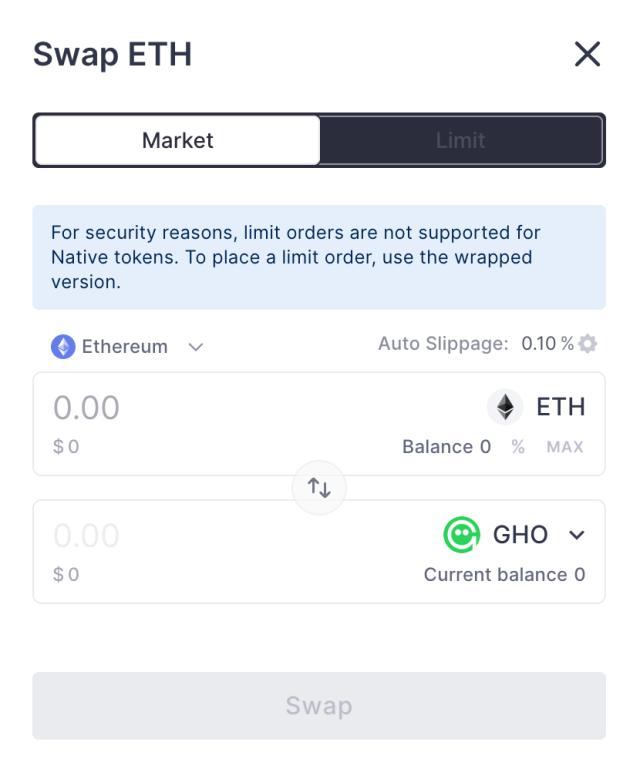The RWA (Real-World Asset) sector is growing at an astonishing pace. Just a few days ago, the total value of RWAs hit a new high, and today it has broken that new record.
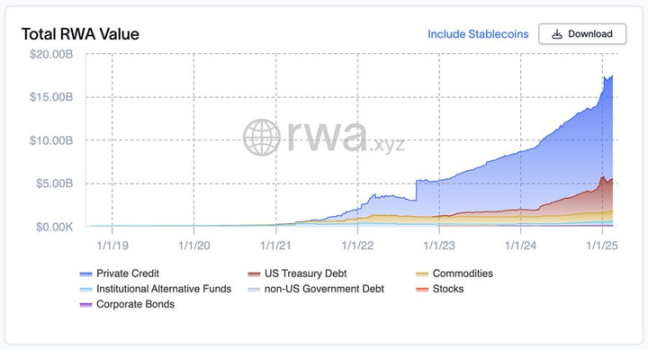
1. RWA TVL
Although many challenges related to privacy solutions, digital identity solutions, interoperability, etc. continue to cause operational friction and act as bottlenecks for faster adoption, the $2-3 billion raised through on-chain fundraising and the approximately $200 billion in Altcoins demonstrate the growing interest and adoption in this area of the Web3 industry.

The current Tokenized funds only represent a small portion of the expected growth in the fund industry over the next few years.
Similarly, the growth in the private credit space also reflects the increasing interest of market participants in opportunities beyond Bitcoin, DeFi native yields, Altcoins and meme Tokens.
According to data from @Preqin, the global private credit market has an investment size of nearly $1.7 trillion, while according to data from @RWA_xyz, the size of Tokenized private credit is only about $11.9 billion.

Active Loan Value - Private Credit Market (Source: RWA.xyz)
Delving deeper into this area, I think it's necessary to mention that the reliability of these loans has undergone a huge change since the market crash in 2022, with teams across platforms becoming more cautious and investing more resources to ensure higher credit quality of the issued loans.
From July 2021 to the end of 2022, the borrowing was mainly dominated by crypto trading and market making companies. As a result, this area of borrowing collapsed during the 2022 bear market.
Since then, the growth has primarily come from real-world borrowing backed by consumer asset-backed securities (such as auto loans, credit card debt, student loans, small business loans, etc.), real estate bridge loans, trade finance, and other less volatile asset classes.

Liquidity Pools of Various RWA Transactions
Proof of this is the performance of resilient protocols like @maplefinance in the liquidation event on February 3, 2025 - the largest liquidation event in crypto history. More details can be found at the following link: https://x.com/maplefinance/status/1886332880411832514 Additionally, the industry has seen significant maturity over the past three years, with technological solutions continuously emerging to address regulatory and privacy obligations, further improving this critical area.
2. Scale of Opportunity
According to data from @BCG, Tokenization of the global mutual fund universe could unlock an additional $100 billion in returns for investors annually. Meanwhile, "sophisticated investors" (sorry, not you) can earn $400 billion (in plain terms, day trading) by "capturing intraday value changes". Looking at the historical adoption pattern of ETFs, it is reasonable to expect that Tokenized funds will account for 1% of global mutual fund and ETF assets under management within the next seven years.
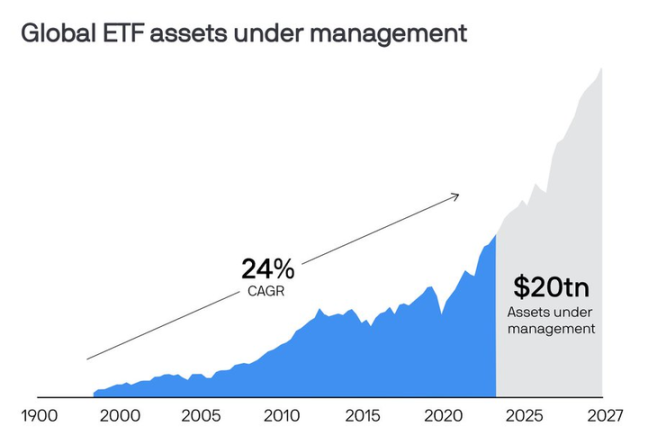
Global ETF Assets Under Management (Source - J.P. Morgan Asset Management)
This means that by 2030, Tokenized assets will exceed $600 billion.
Furthermore, if regulators allow existing mutual funds and ETFs to convert to Tokenized funds (which is simpler than launching a new Tokenized fund), we may see trillions of dollars in assets under management.
Considering the similar growth expectations prior to the launch of a BTC ETF, I don't think we can rule out the possibility that these numbers may be too conservative, and the actual growth could be astoundingly high.
However, even based on these projections, we are still talking about at least a 200-fold increase.
Let me repeat that, at least a 200-fold increase from now.
And you're still sitting there, frustrated because you haven't made any money yet?
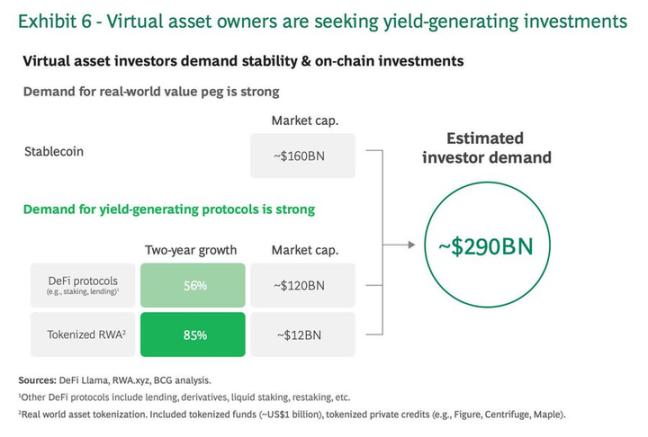
Give me the returns, please!
According to this @BCG research, the industry's investment demand for Tokenized funds is around $290 billion. This figure includes the demand from Altcoin holders, Tokenized RWAs, and DeFi protocols.
I think this number may be on the high side, as they have considered the growth in the market capitalization of DeFi protocols, which is driven by a more risk-tolerant user base, and their investment preferences may differ from those willing to invest in Tokenized assets.
A more reasonable approach would be to consider the growth in the Total Value Locked (TVL) of DeFi over the past two years, which, even then, would still be a considerable figure: $58.06 billion (source - @defillama).
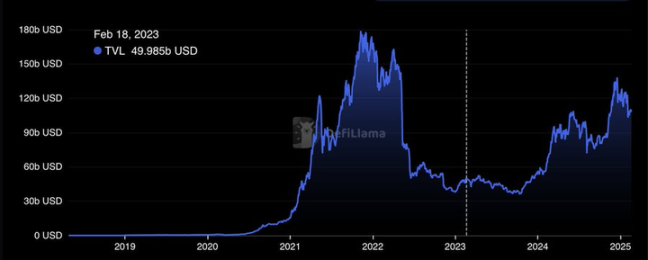
DeFi Total Value Locked (TVL)
Nonetheless, the value proposition of Tokenized funds and RWAs is undeniable. They provide a channel for investors to access real-world investment opportunities, allowing them to better diversify their portfolios as market dynamics change.
Imagine if you could have converted your on-chain Tokens to stocks, commodities, and real estate through @Rabby_io over the past few months without having to cash out. Wouldn't that be convenient?
But why must all of this happen? What's in it for traditional finance? I haven't seen much discussion on this topic lately on Crypto Twitter (CT), especially amidst the meme coin hype and drama. We're always talking about how traditional finance (tradFi) is entering the Web3 space and adopting the technologies we're building. But why would they do that? While I plan to write a dedicated article on this topic, here are some key points on why traditional finance needs and must adopt the crypto rails:
- Instant settlement as shown in the image below, which could add around $50 billion to investors' portfolios annually.
- Lower commissions, another $33 billion in savings that would ultimately flow into investors' portfolios.
- Composability - Tokenized funds will be more easily lendable.
- Accessible trading - Tokenization will make it easier for investors to trade assets.

How Tokenization Improves Returns (Source: Boston Consulting Group)
3. Sentiment Second, Momentum First

Traditional finance is bidding, while Crypto Twitter (CT) is getting slaughtered.
The chart above shows that, regardless of market conditions, especially the sentiment in Crypto Twitter (CT), the interest of traditional finance (tradFi) institutions in Tokenization, crypto, and Blocks is stronger than ever before.
This should remind you of how incredible the next few years will be.
Think about it: if traditional finance institutions were interested in Tokenization and crypto in the past - even when there was almost no adoption, unfriendly regulation, and less innovation - why wouldn't they be exceptionally bullish on it now?
The answer is simple.
You know it.
4. How's the Crypto Market Doing?
Even though market participants' sentiment is at historical lows, with most discussions focused on @KaitoAI's nonsense, Solana's meme coin rug pulls, and the dramatic events of KOLs, the charts are loudly expressing a different voice.
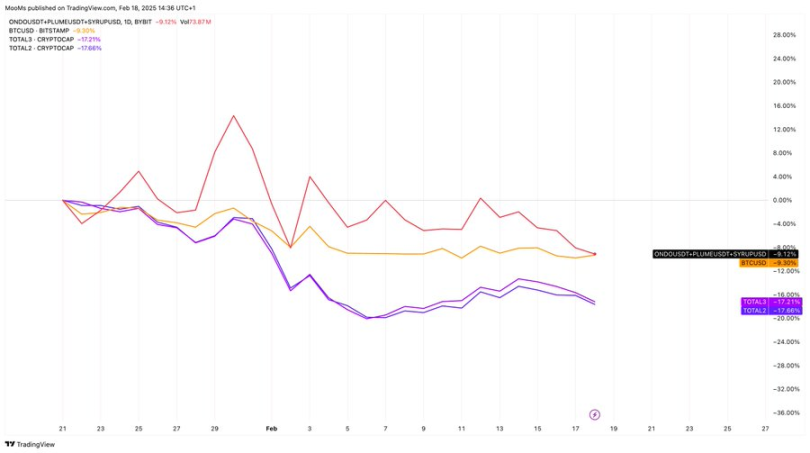
Data doesn't lie. Since the launch of $TRUMP, the performance of leading RWA protocols has outperformed, or rather, proven their resilience compared to the overall Altcoin market.
If you include more leading RWA protocols in the index and look at a longer time frame, the results would be the same.
5. Conclusion
The RWA field is like a huge cake, and so far we've only cut a small slice. However, those who tokenized early will get a big piece, while others can only pick up the crumbs. Traditional finance knows this, which is why they are accelerating the process.
I will end with a quote from a report by @DigitalAssets: "Looking ahead to 2025, it's clear that investors haven't missed the opportunity to join the digital asset wave. In fact, we believe we may be entering a new era of digital assets, one that is expected to span many years - even decades. This era may see digital assets permeate across industries - industrial, technological, domains, balance sheets, and even at a national level. The key question facing investors now is not whether to participate, but how they will actively participate in this transformation."







